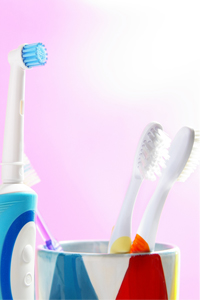
Back and forth goes the argument—what toothbrush is best?
Gadgeteers can spend $150 for an electric brush designed to rotate and oscillate, with an angled neck, a sure-grip handle, dual speed control, and even a timer. Researchers say that rotation-oscillation electric brushes remove plaque and reduce gingivitis better than any other kind—but only slightly better.
Do-it-yourselfers can pick up a manual toothbrush for under $3 at the pharmacy. Replace it every three months for two years—the warranty period on the electric brush—and you can save big bucks.
Kids often prefer electric brushes because the smaller brush head makes it easier to reach those hard-to-reach back teeth. They also like the buzz or one of the singing toothbrushes.
Electric brushes are often the perfect choice for people with limited use of their hands, increasing independence in personal hygiene.
Electric brushes require a lighter touch, just gentle guidance. Some might prefer a manual toothbrush over learning a new brushing style.
The most important factor: will you brush for at least two minutes at least twice a day?
If it also happens to be your favorite color, so much the better. Because no matter how bright and shiny, how unique its bells and whistles, your toothbrush won’t do you any good unless you use it.
Your quality toothbrush should have:
- a handle that fits your grip and doesn’t slip;
- a head small enough to reach all areas of your mouth and teeth.
